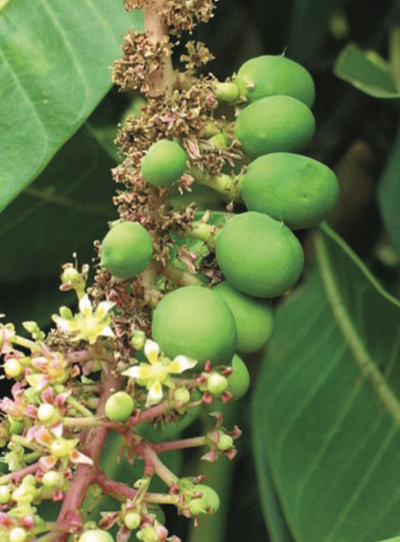We are arguably the largest mango producing country in the world, with annual mango production of 16,337,400 tons a year. If we get mango flowers earlier, it’s not a sign that we will get fruit earlier, if it’s not the season for pollinators. Instead we will get far less fruit.
MARIANNE FURTADO DE NAZARETH
As I parked my car way back in 2010, under a mango tree in the St. Joseph’s College
of Arts and Science, PG Block, I was surprised to notice the branches weighted down with green mangoes and flowers in November. Teaching Science and Environment Journalism my curiosity was piqued. I remembered mango trees flowering much later, toward the end of February and the month of March, to give us mangoes during our vacations in May. What was happening? Was Climate Change changing fruit trees flowering patterns I wondered.
The best way to find out was to talk to Dr. Yellappa Reddy, former secretary, Department
of Ecology and Environment, Government
of Karnataka and present Chairman of the Bangalore Environment Trust. Through my years writing for the Hindu and the Deccan Herald, Dr. Reddy was always at the end of a phone call, advising and clarifying my doubts about the trees and the environment of our planet.
“Mango trees flowering in the months of November and December has become a common occurrence in Bengaluru. Strange as most old residents of the city will recall, they usually would flower only at the end of February and bring us fruit in May. However, now in the city, the trees are heavily laden with flowers and in some cases tiny mangoes as well, in November itself,” he said.
He explains the phenomenon, which has both a positive and a negative effect. He says the phenology of tropical fruit depends on the temperature and the humidity present in the air in that particular season. The fertility gradients in the branches of the tree, and it’s primordial buds, is fixed in advance. These primordial buds are affected by humidity and temperature and here in Bengaluru regional climate change plays an important role in inducing the primordial buds early.
The disadvantage is that the pollinators which are the bees, ants and beetles who play an important role in cross-pollination may not be present when it’s not the season and therefore most flowers wither away, as these natural pollinators cannot help in producing fruit. Only 10% of the flowers may sustain themselves and withstand climate change stress, till the actual season arrives after which they grow into fruit. But nothing can happen without the help of pollinators. No pollinators,
low crop yield.
Plus and a big plus is
the role of air quality which
includes pollution. This
also plays an important role
in growing a healthy crop
of mangoes. Bangalore is
known for at least 30-40
days of mist and fog in the
early mornings. This mist also plays a large role he explains. Mist increases the humidity in
the air and the moisture level. All these factors control and regulate the yield—it’s quantity and quality. With Climate Change changing the fruiting season, we still are able to collect a crop thankfully, but earlier than expected and much less fruit to enjoy.
In a paper entitled: “Impact of Climate Change on Tropical Fruit Production Systems and its Mitigation Strategies” by Vishal Nath, Gopal Kumar, S. D. Pandey, Swapnil Pandey they believe that tropical fruits are attuned to the prevailing weather conditions marked by high temperature. There are delineated and need definite ranges of temperature at different phenophases, for the optimum production of different fruits. Any deviation from the optimum is likely to affect production and quality drastically. The complex interaction of altered temperatures, corresponding phenophases of different fruits, relative suitability of species, elevated CO2, reduced water availability, pollinators, pest and disease and management practices have demonstrated impact on yield and thus will largely determine the tropical fruit production.
So no, if we get mango flowers earlier, it’s not a sign that we will get fruit earlier, if it’s
not the season for pollinators. Instead we will get far less fruit. That’s rather sad as people
all over the world enjoy our Indian mangoes. We are arguably the largest mango producing country in the world, with annual mango production of 16,337,400 tons a year. A very wide variety of mangoes can be found across the country in India, with several states boasting
of their favourites. Each of us too have our own particular variety which we enjoy. Mine are the thick and leathery skinned Malgoba, with its wonderful stringless flesh and the new variety — a cultivar called the Mallika. It has a very thin and flat seed and the most wonderful orangey flesh which anyone will enjoy.
Lalbagh sells these graft saplings in their Nursery with plants at a very reasonable price. Then once you have planted the sapling and nurtured it, in five years you can enjoy your first crop of mangoes.
However, the most favoured variety hails from the Konkan region and is commonly known as the Alphonso. History says it was the Portuguese who introduced grafting on mango trees, to produce extraordinary varieties like the Alphonso.
∎